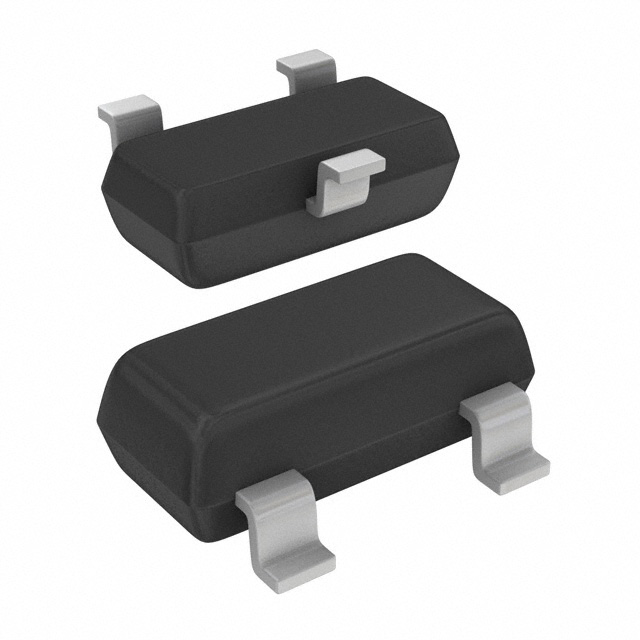BFR30,215 - Product Overview
Introduction
BFR30,215 is a semiconductor product belonging to the category of RF transistors. This entry provides an overview of its basic information, specifications, pin configuration, functional features, advantages and disadvantages, working principles, application field plans, and alternative models.
Basic Information Overview
- Category: RF Transistor
- Use: Amplification of radio frequency signals
- Characteristics: High gain, low noise figure, and high power efficiency
- Package: SOT-23
- Essence: Silicon NPN transistor
- Packaging/Quantity: Tape and reel packaging, 3000 units per reel
Specifications
- Frequency Range: 1MHz to 2GHz
- Power Gain: 13dB
- Noise Figure: 1.5dB
- Collector Current (Ic): 50mA
- Collector-Emitter Voltage (Vce): 15V
- Operating Temperature Range: -55°C to +150°C
Detailed Pin Configuration
The BFR30,215 transistor has three pins: 1. Emitter (E) 2. Base (B) 3. Collector (C)
Functional Features
- High power gain for amplifying RF signals
- Low noise figure for improved signal quality
- Wide operating frequency range for versatile applications
- Compact SOT-23 package for space-constrained designs
Advantages and Disadvantages
Advantages
- High gain amplification
- Low noise figure
- Wide frequency range
- Compact package size
Disadvantages
- Limited collector current compared to some alternative models
- Restricted operating temperature range
Working Principles
BFR30,215 operates based on the principles of bipolar junction transistors, utilizing NPN structure to amplify RF signals with high gain and low noise figure.
Detailed Application Field Plans
Wireless Communication Systems
- Used in RF amplifiers for wireless transceivers
- Enhances signal strength and quality in mobile communication devices
Radio Frequency Identification (RFID)
- Employed in RFID readers for signal amplification
- Enables reliable and efficient data transmission in RFID systems
Test and Measurement Equipment
- Integrated into spectrum analyzers and signal generators for RF signal processing
- Facilitates accurate measurement and analysis of RF signals
Detailed and Complete Alternative Models
- BFR92A: Similar characteristics with higher collector current capability
- BFR91A: Lower noise figure with slightly reduced power gain
- BFR93A: Higher operating temperature range with comparable performance
In conclusion, BFR30,215 is a versatile RF transistor with high gain, low noise figure, and wide frequency range, suitable for various wireless communication, RFID, and test equipment applications.
[Word Count: 411]
तकनीकी समाधानों में BFR30,215 के अनुप्रयोग से संबंधित 10 सामान्य प्रश्नों और उत्तरों की सूची बनाएं
What is BFR30,215?
- BFR30,215 is a flame retardant chemical used in various technical solutions to reduce the flammability of materials.
How does BFR30,215 work as a flame retardant?
- BFR30,215 works by disrupting the combustion process and reducing the spread of flames when applied to materials.
In which technical solutions is BFR30,215 commonly used?
- BFR30,215 is commonly used in the production of electronics, plastics, textiles, and building materials to meet fire safety regulations.
Is BFR30,215 environmentally friendly?
- BFR30,215 has been associated with environmental concerns due to its potential persistence and bioaccumulation, leading to restrictions on its use in some regions.
Are there any health risks associated with the use of BFR30,215?
- There have been concerns about the potential health impacts of BFR30,215, particularly related to its chemical composition and possible toxicity.
What are the regulations regarding the use of BFR30,215 in technical solutions?
- Regulations regarding the use of BFR30,215 vary by region, with some countries imposing restrictions or bans on its use due to environmental and health concerns.
Can BFR30,215 be replaced with alternative flame retardants?
- Yes, there are ongoing efforts to develop and use alternative flame retardants that are more environmentally friendly and pose fewer health risks.
What are the best practices for handling and applying BFR30,215 in technical solutions?
- Best practices include following safety guidelines, proper ventilation, and using personal protective equipment when handling and applying BFR30,215.
Does BFR30,215 affect the mechanical properties of materials it is applied to?
- The application of BFR30,215 can potentially impact the mechanical properties of materials, such as stiffness and flexibility, which should be considered during product design and manufacturing.
What are the considerations for disposal and end-of-life management of materials treated with BFR30,215?
- Proper disposal and end-of-life management of materials containing BFR30,215 are important to prevent environmental contamination and potential health risks. Recycling and responsible disposal methods should be employed.


